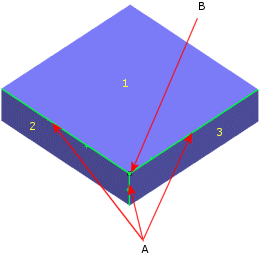Usually one reference is needed to specify the motion at a location. However, a location can receive multiple assignments when it is common to higher entities with prescribed restraints. For example, suppose that you applied symmetry condition to faces 1, 2, and 3 shown in the figure below. The three edges (A) that are common to faces will receive restraints in two references. The common vertex (B) will receive restraints in three different references. The software enforces all specified restraints. If it finds a contradiction, it will give a message before stopping the analysis.

As an example, if you fix Face 1 completely and prescribe a normal motion of 0.01” at Face 2, a contradiction arises at the common edge. Another example is illustrated in the following figure.

Suppose that vertex A is constrained (no motion) in direction 1 of Plane1 (global X), and the cylindrical face is given a radial displacement of 0.1”. Obviously there is a contradiction at vertex A. The analysis program will give a message and stop. However, if the tangential rotation of the face is set to a value while the radial motion is prevented, there is no contradiction and the analysis continues.